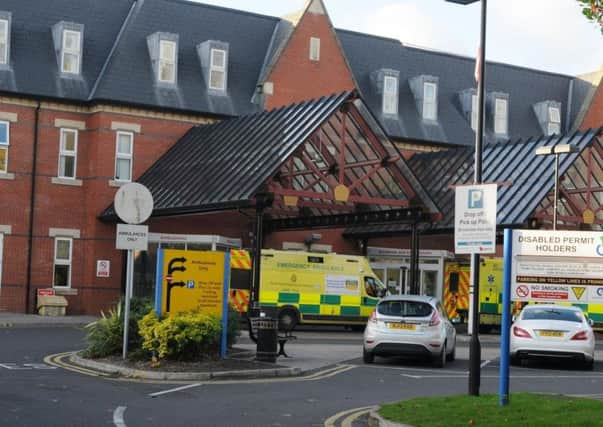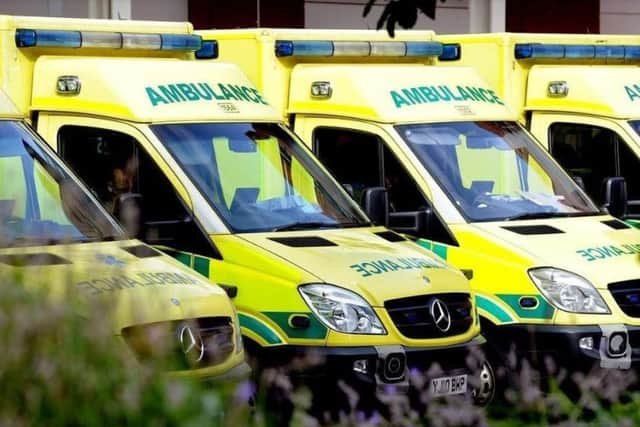One in six people had four-hour wait at Wigan A&E


And nearly a quarter of patients - 23.11 per cent - had to wait more than 30 minutes to be handed over to staff by paramedics in November.
The figures were revealed in reports to this week’s meeting of Wigan Borough Clinical Commissioning Group’s governing body.
Advertisement
Hide AdAdvertisement
Hide AdPapers prepared for the meeting detailed the performance of Wigan Infirmary’s A&E department and North West Ambulance Service (NWAS).


In November, it took more than 30 minutes for paramedics to hand over 23.11 per cent of patients - far higher than the 4.7 per cent target.
And 8.5 per cent of patients waited more than 60 minutes, compared to the 0.5 per cent target.
That meant that of the 1,848 arrivals by ambulance in November, 427 faced delays of more than 30 minutes and 157 waited for longer than 60 minutes.
Advertisement
Hide AdAdvertisement
Hide AdNWAS responded to 67.3 per cent of the most urgent calls - named “red one” - and 58.6 per cent of “red two” calls in Wigan within eight minutes. The target for both is 75 per cent.


This compares to 62.8 per cent of red one calls and 60.35 per cent of red two calls across the North West.
There is a 95 per cent target to respond to all red calls in 19 minutes, but in Wigan this was met 84.5 per cent of the time and 86.79 per cent in the North West.
Last week, the Evening Post reported that NWAS had been rated as “requires improvement” by inspectors from the Care Quality Commission.
Advertisement
Hide AdAdvertisement
Hide AdThe meeting also received a report about the performance of A&E at Wigan Infirmary during November and December.
Bosses had appealed for people to stay away over Christmas and New Year as the department was “under immense pressure”.
Patients who were not deemed to be an emergency or seriously ill faced waits of up to six hours to see a doctor.
The new figures show 82.54 per cent of patients were seen in four hours in December and 83.52 per cent in November.
Advertisement
Hide AdAdvertisement
Hide AdThat falls short of the 95 per cent target set by the Department of Health, which Wigan Infirmary has not met for more than a year.
It compares to 93.27 per cent in November 2015 and 93.64 per cent in December 2015.
The report stated: “There are a number of contributing factors in the failure to meet the national target over the festive period.
“There were a large number of beds closed with diarrhoea and vomiting and other infectious conditions, this included three acute wards equalling 63 beds over a two-week period.
Advertisement
Hide AdAdvertisement
Hide Ad“In addition there were also seven care homes closed with diarrhoea and vomiting infection leading into the festive period which had an impact on discharges out of hospital.
“The acute trust also had staff sickness due to which included nursing and medical staff. This caused issues on the A&E department especially on timely assessments.
“The system also experienced an increase activity from out of area attendance and admissions, mainly Chorley via NWAS.”
The report reveals there were actually fewer people attending A&E in November and December 2016, compared to the year before.
Advertisement
Hide AdAdvertisement
Hide AdIn November there were 7,235 attendances - 328 fewer than in 2015 - and in December there were 7,470, a reduction of 35.
Admissions increased in both months. They rose from 1,796 in November 2015 to 1,952, and from 1,876 in December 2015 to 2,088.
The report detailed the work being done to improve performance at A&E.
An integrated discharge team was set up six months ago to address delays in patients leaving the hospital.
Advertisement
Hide AdAdvertisement
Hide AdA “surge and escalation” process is being finalised and will be used when there is increased pressure, which can include more than 299 people attending A&E in one day.
Other steps include streaming patients with primary care conditions at the A&E front door and a care home committee being set up.
A spokesman for NWAS said: “We are continuing to see a high demand for our service, specifically from patients with life-threatening conditions.
“It is not only the ambulance service seeing this increase in patients; it is happening across the NHS.
Advertisement
Hide AdAdvertisement
Hide Ad“Busier hospital emergency departments (EDs) result in ambulance crews having to wait longer to handover patients into the care of hospital staff before they are able to get back out on the road to respond to other emergencies.
“We monitor ambulance handover times daily and are working closely with our NHS colleagues and CCGs to address the issue through a number of initiatives. This includes placement of ambulance liaison officers in EDs who aim to speed up turnaround times for ambulance crews.
“We do our best to treat patients at home wherever possible and ensure that only patients who need to be there are taken to hospital. This month, 47 per cent of patients treated by ambulance crews in Wigan have not been taken to the emergency department. Instead we have referred them to more appropriate care through our initiatives such as the GP referral scheme, falls response team, community diabetes team and community assessment for mental health patients.
“We urge the public to support us by only dialling 999 for life-threatening and potentially life-threatening incidents and to consider alternative pathways of care such as minor injury units, walk-in centres or visiting their GP or pharmacist in the first instance.”
Advertisement
Hide AdAdvertisement
Hide AdDr Tim Dalton, GP and chairman of NHS Wigan Borough CCG, said: “Christmas and New Year was a tough time for the NHS, and A&E in particular. At these times, all the teams work together to try and reduce the impact on patients.
“As well as working with the hospital to support them in managing the performance at A&E, we are working to try and ease pressure on A&E in the long term. This includes improving community services through the new integrated community services to reduce attendances and help the hospital discharge back to the home safely as quickly as possible.
“It also includes looking at the role of GPs in A&E to see and treat those people who don’t need the full A&E support, but could have been seen by their doctor.”